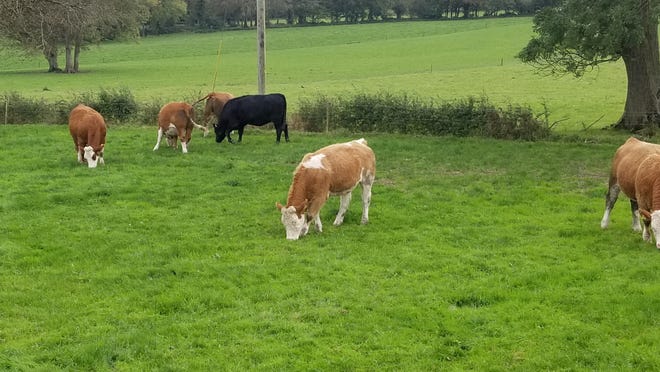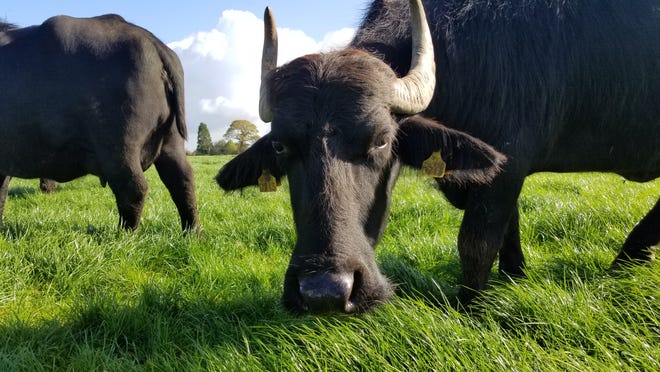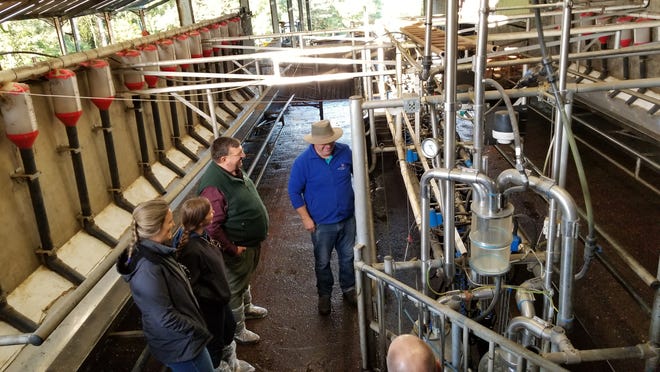Extension staff find Irish, Wisconsin dairy farmers have much in common
 Colleen Kottke
Colleen KottkeAlthough the two countries are nearly 3,600 miles apart, University of Wisconsin Extension agents and educators discovered that farmers in Ireland are faced with many of the same challenges as their counterparts back in the Badger state.
Extension Agriculture educators Tina Kohlman, Fond du Lac County, Aerica Bjurstrom, Kewaunee County and Dan Marzu, Lincoln and Langlade counties, traveled to Ireland as part of the National Association of County Agriculture Agents Ireland Agriculture & Culture Tour along with 70 other Extension colleagues from across the U.S.
Kohlman says on a global scale, dairy farmers from one country to another are facing the same challenges when it comes to land stewardship, preserving the environment, bringing the next generation on board, being mindful of resources and thinking outside the box to find value-added and niche markets.
"We're all in this together even though we have an ocean between us," Kohlman said.
The Emerald Isle
With just half the land mass of the state of Wisconsin, land is a priceless and closely held asset on the Emerald Isle. This makes it both difficult for farmers to expand or new farmers to get started in the business.
Bjustrom points out that on average land changes ownership in Ireland every 555 years.
"Rental land is much easier to obtain, but with limited land available and only small acreage available, finding what you need where you need it is very challenging," she said.

Marzu says this makes it especially difficult for young individuals without any family ties to the dairy industry.
"Land is rarely sold as it's handed down from generation to generation," he said. "Even then if a member of the family wants to sell land it has to go to the family first to see if anyone wants to take it over."
Marzu says farmland that is sold is very expensive, going for as much as $10,000 an acre.
Land Stewardship
Farms are also smaller in Ireland, averaging around 70 acres. Surrounded by the Atlantic Ocean and Irish Sea, farmers also have to contend with 900 miles of coastline and Karst topography, something Bjurstrom is familiar with in Kewaunee County.
"A large portion of Ireland is on Karst soil, with varying depths of bedrock. There are some places in the country where the bedrock formations protrude 20 feet or more above the surface and other places where it is buried under significant soil cover, she said.
Due to its geological considerations, Bjurstrom said the country as a whole has cut-off days when a synthetic and manure-type fertilizers can be applied,
"Chemical fertilizers can't be applied from Sept. 25 to Jan. 1," she said. "Manure fertilizers cannot be applied between Oct. 15 to Jan. 1."

Because Irish farmers use a heavy grass-based dairy system, most livestock are removed from pasture by mid-October to preserve the integrity of the pasture for the following season.
"There are a lot of farms along the coastline and rivers so they have to be really good stewards about manure run-off to protect their land so they can continue to use those fields for grazing," said Kohlman.
In the country's GLAS (Green, Low Carbon, Agri-Environmental Scheme) program, Irish farmers are required to regulate manure, fertilizer application rates and timings; provide fencing around streams in pastures; have hedgerows and a cover crop planting program. Farmers also must acquire permission to have fields larger than 12.5 acres.
"The potato farm that we visited uses a grass filtration system to remove contaminates from the water used for washing potatoes before it reaches the surface water," Marzu said. "The farm also only plants potatoes in a field every seven to eight years. This rotation helps with managing diseases in the crop."
Lush pastures
The mild Irish climate with abundant rainfall, rich soil and ideal grass-growing conditions produce lush pastures ideal for intense grazing.
The dairy industry in Ireland processes 7.4 billion liters of milk each year, supplied by 18,000 family farms. As opposed to Wisconsin's tradition of confinement dairy operations, Irish dairies have very low inputs and low production of about 12,500 pounds per cow each year.
The grass-based, sustainably produced milk provides an excellent source of premium-quality dairy rich in components of 5.5 percent butterfat and 4.25 percent protein.
"Like in the U.S., farmers get paid a premium for components. But unlike the U.S., they get a discount for volume," Bjurstrom said.
According to the Irish Agriculture and Food Development Authority, 91% of the milk in the country is produced by spring calving herds. Of the 7.4 billion liters of milk, 500 million liters is used as liquid milk while 6.5 billion liters is used in manufacturing.
Sixty percent of that milk is used for butter production while 25% is used for cheese production. Eighty-five percent of milk production is exported.
"While we were there, Brexit was weighing heavy on the minds of producers. They export quite a bit of what they produce, so taking the United Kingdom out of the equation would have impacted them significantly, especially in the cheese market," Bjurstrom said.
Finding a niche
Marzu says the Farm to Fork movement is just beginning in Ireland, creating much potential for growth in the market.
"Of the farms we visited, they all seem to be progressive in looking at new ideas to help themselves and their neighbors," Marzu said.
The Lincoln and Langlade county agent said a 2,500 head dairy sheep farm is a prime example of the growing agri-tourism movement spreading across the country. Not only does the farm market the milk from its seasonal flock, visitors pay to watch sheep dog herding demonstrations along with the opportunity to learn to shear a sheep.
"By doing this the farm has become completely self-sufficient and does not rely on the subsidies of the government," he said. "They also employ area farmers, such as the sheep shearer, so they can have additional income to support their farm. They also sell a variety of lanolin hand creams made by area farms."

When faced with falling milk prices 10 years ago, Johnny Lynch made the bold move to import a herd of water buffalo from Italy. Today the former dairy farmer is milking a herd of the gentle beasts on the Macroom Buffalo farm in Cork, in the southwest of Ireland.
Today Lynch's herd of 75 milking water buffaloes produces several cheeses including ricotta and mozzarella to outlets across the country.
"This was such a great story to hear of farmers trying to increase the income on their farm by using different animals, building their own cheese processing plant and going out and looking for markets for that cheese," said Kohlman. "They recently opened up the farm for tour groups who are able to walk out in the lush pastures and hang out with these gentle creatures."
Public perception
Bjurstrom says public perception that the European Union is so much more progressive in its farming practices — banning pesticides and GMO s— than in the U.S. aren't all that they seem.
She tells of a young cash crop farmer they met who expressed his frustration with the crop diseases he encounters due to the climate and lack of GMO crops.
"He said that he spends a lot of time and money spraying for those diseases when a GMO crop would be naturally immune," she said. "There is definitely a sense of frustration from farmers in Ireland about how people who don't know anything about farming are dictating change based off what they learned on Google."

Marzu says the agriculture industry in Ireland is very consumer driven.
"If there's enough demand for the way a product is raised or grown, that would mean the farmer would have to change the methods he uses, and look into the practice to fill that need," Marzu said. "The farmers want some security that the market would maintain and be financially sustainable for them to make that change."
Information exchange
For 112 years, Extension agents/educators have provided educational programs, expertise, research, resources and services in all 72 Wisconsin counties. Kohlman says Ireland also values the mission of sharing information.
"We visited their Ag Research Station and learned it was very similar to what we do. It's also research-based and focused on what the community needs. How they disseminate that information and perform outreach through county-like agents is also very similar to what we do," she said. "They also have field days that cover grazing, feeding, reproduction and animal husbandry."
Kohlman pointed out that UW Madison Professor Paul Fricke took a six-month sabbatical over in Ireland working at the research station.
"In addition, we were also able to compare notes and share information with our colleagues from across the U.S. which was very useful," she said.
Funding for the professional development opportunity was provided by a 2019 Dean's Meritorious Award, Epsilon Sigma Phi Professional Development Award and a 2019 Area 15 County Extension Professional Development Fund.